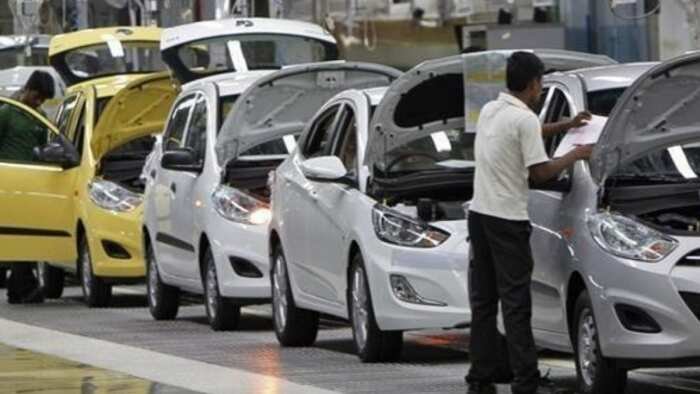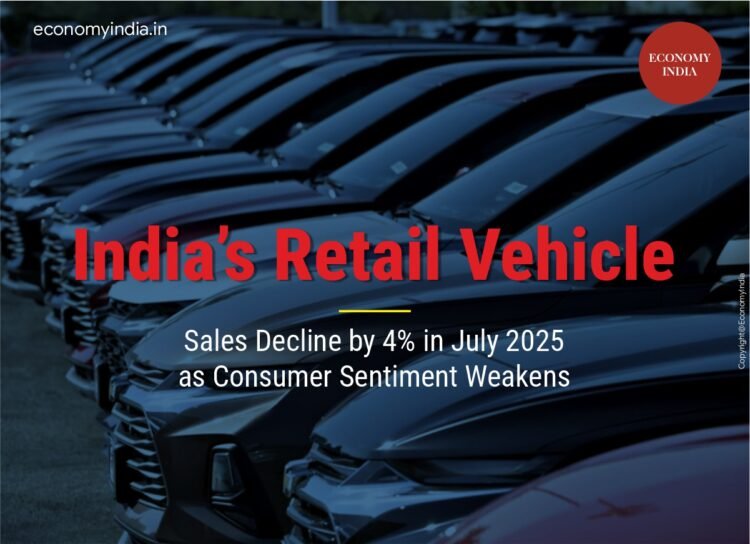Passenger and two-wheeler segments face demand pressure; total registrations fall to 19.64 lakh units: FADA
New Delhi | Economy India: India’s automobile retail market witnessed a notable deceleration in July 2025, with overall vehicle registrations dropping by 4% year-on-year, as reported by the Federation of Automobile Dealers Associations (FADA). The decline, attributed primarily to subdued demand in the passenger vehicle (PV) and two-wheeler segments, reflects ongoing challenges in both urban and rural consumption.
According to the FADA data released on Thursday, total registrations in July 2025 stood at 19,64,213 units, down from 20,52,759 units recorded in July 2024. This contraction in sales comes at a time when the auto industry had been pinning hopes on revival, driven by easing interest rates and approaching festive seasons.

Segment-Wise Performance: Passenger and Two-Wheelers See Red
The decline was led largely by weak performance in the two core segments:
- Passenger Vehicles (PVs): After showing signs of recovery in the previous quarter, PVs saw a reversal in July. Rising input costs, price increases by manufacturers, and delayed new model launches were cited as key deterrents to consumer buying.
- Two-Wheelers: This segment—traditionally driven by rural and semi-urban demand—suffered due to weak agricultural sentiment, high fuel prices, and inflationary pressure on discretionary spending.
“The market has turned cautious. July’s decline is reflective of both economic and seasonal uncertainties. Dealers across India have reported reduced footfalls and deferrals in bookings,” said Manish Raj Singhania, President, FADA.
Commercial Vehicles and Tractors: A Mixed Bag
While the overall trend was negative, other segments showed a more mixed performance:
- Commercial Vehicles (CVs): The segment showed marginal growth, supported by continued infrastructure development and freight movement. However, demand remained uneven across geographies.
- Tractors: A key indicator of rural economic activity, tractor sales held steady but did not witness a robust surge, mainly due to irregular monsoon and delayed kharif sowing in key agrarian states.
FADA cautioned that unless rural confidence improves, especially with rainfall stabilizing, the upcoming months may continue to reflect patchy performance across categories.
Economic Headwinds and Monsoon Uncertainty
Experts pointed to a confluence of factors that dragged down retail auto performance in July:
- Erratic monsoon patterns have disrupted the sowing season, which directly affects rural income and vehicle purchasing.
- Inflation and fuel prices continue to dent consumer sentiment, especially in entry-level segments.
- High vehicle financing costs have also led to a delay in purchase decisions, despite offers and dealer incentives.
“July has historically been a lean month. But this year, external economic pressures coupled with unpredictable weather have worsened the cycle,” said Anurag Jain, a Delhi-based auto analyst.
Dealer Feedback: Inventory Pressure and High Expectations from Festive Season
Dealers across the country have expressed concern about inventory build-up and the need for more realistic dispatch planning by OEMs. With Onam and Ganesh Chaturthi around the corner, many are hopeful of a recovery in August–September.
“There is hope on the horizon, but the footfall and conversion ratio must improve. OEMs need to align dispatches with actual demand, else dealerships will face financial strain,” noted FADA.
Looking Ahead: Will the Festive Season Bring a Turnaround?
The upcoming festive period, traditionally a high point for vehicle sales, is now critical for automakers and dealers alike. FADA has urged all stakeholders to adopt a cautiously optimistic approach while remaining agile in operations.
The association expects:
- Better traction in urban markets due to festive sentiments
- Launch of new vehicle models in PV and SUV categories
- Financial incentives and flexible EMIs to boost retail buying
However, much depends on the progress of the monsoon, inflation trends, and macro-economic stability.
Auto Retail Faces Critical Quarter Ahead
India’s auto sector, a key barometer of economic activity and consumer confidence, is navigating through a challenging terrain. The July numbers serve as a reminder of the fragile recovery, especially for mass-market segments.
While long-term fundamentals remain strong—driven by urbanization, aspiration, and infrastructure—short-term headwinds demand adaptive strategies from automakers, policymakers, and financing institutions alike.
The coming quarter will be decisive in determining whether the industry can shift gears towards sustained growth, or whether structural headwinds will continue to act as speed bumps.

Key Data Points (July 2025 vs July 2024):
| Vehicle Category | July 2025 | July 2024 | % Change |
|---|---|---|---|
| Total Registrations | 19,64,213 | 20,52,759 | -4.3% |
| Passenger Vehicles | Declined | – | Negative |
| Two-Wheelers | Declined | – | Negative |
| Commercial Vehicles | Marginal Growth | – | Slight + |
| Tractors | Flat | – | Stable |













